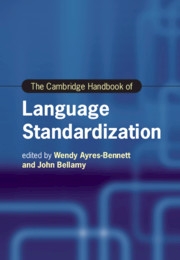Book contents
- The Cambridge Handbook of Language Standardization
- cambridge handbooks in language and linguistics
- The Cambridge Handbook of Language Standardization
- Copyright page
- Contents
- Figures
- Tables
- Contributors
- Introduction
- Part I Revisiting Models and Theories of Language Standardization
- 1 Modelling Language Standardization
- 2 Language Standardization ‘from Above’
- 3 Language Standardization in a View ‘from Below’
- 4 Social Cohesion and Emerging Standards of Hindi in a Multilingual Context
- 5 Standardization in Highly Multilingual National Contexts
- 6 Standardization of Minority Languages
- Part II Legitimacy, Authority and the Written Form
- Part III Norms, Literacy and Education
- Part IV Beyond the National
- Part V Standardization in Late Modernity
- Name Index
- Subject Index
- References
1 - Modelling Language Standardization
from Part I - Revisiting Models and Theories of Language Standardization
Published online by Cambridge University Press: 01 July 2021
- The Cambridge Handbook of Language Standardization
- cambridge handbooks in language and linguistics
- The Cambridge Handbook of Language Standardization
- Copyright page
- Contents
- Figures
- Tables
- Contributors
- Introduction
- Part I Revisiting Models and Theories of Language Standardization
- 1 Modelling Language Standardization
- 2 Language Standardization ‘from Above’
- 3 Language Standardization in a View ‘from Below’
- 4 Social Cohesion and Emerging Standards of Hindi in a Multilingual Context
- 5 Standardization in Highly Multilingual National Contexts
- 6 Standardization of Minority Languages
- Part II Legitimacy, Authority and the Written Form
- Part III Norms, Literacy and Education
- Part IV Beyond the National
- Part V Standardization in Late Modernity
- Name Index
- Subject Index
- References
Summary
In this chapter, I outline the development of some of the most widely used models of standardization and consider the extent to which they are able to account for the complexities of the standardization process and its different manifestations in diverse linguistic, historical and sociocultural contexts. I begin by discussing some of the ‘classic’ texts by Haugen, Garvin, Kloss, Ferguson and Stewart. I trace the establishment of certain key notions, as well as the publication of important texts in the 1980s and 1990s, including those by Milroy and Milroy, Le Page, Joseph and Cooper. I then outline some of the emerging and important themes in the work on standardization since 2000 which have proved challenging for the classic models of standardization. These include the standardization of minority and non-European languages and the consideration of standardization ‘from below’. Other developments concern an increasing focus on the agents of standardization and research on destandarization and restandardization, both of which need to be accommodated in standardization models. I conclude by revisiting Haugen’s model of standardization, which continues to be used in many studies and descriptions of standardization, despite its well-known limitations. I evaluate how far it is still valid and propose some possible modifications.
Keywords
- Type
- Chapter
- Information
- The Cambridge Handbook of Language Standardization , pp. 27 - 64Publisher: Cambridge University PressPrint publication year: 2021
References
- 7
- Cited by



